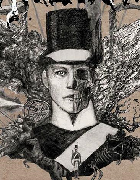|
When did the cool armies start to give tobacco and booze to soldiers and when did the nanny states stop this? I've read about how it was handled in navies, but don't know how it was done on land.
|
|
|
|

|
| # ? Apr 23, 2024 20:24 |
|
ChubbyChecker posted:When I was contemplating on the cavalry, I thought about drilling. Were the native Swedish troops actually better drilled than their opponents? And iirc the musketeers didn't wear armor because it hindered loading the long muskets. To my knowledge they weren't better drilled, but in previous decades they hadn't really been very much drilled in formations at all. Especially the pike and shot acting together on a battlefield - type of action. Some of the Swedish leadership was initially concerned that the native regiments would fight worse than mercenaries, as the mercenaries were considered to be professionals. Native Swedish/Finnish infantry seems to have been used mainly in garrison duties after the first few years, as the were for several reasons believed to be less likely to desert (if they did their villages would have to provide replacements and they usually didn't know languages other than their own, at least initially). At Breitenfeld they seemed to have performed well enough and at Rain/Lech as well (Savolax regiment bridging a river under fire). At Luetzen only one of the Swedish brigades had any native infantry in it, the rest having died or been assigned to garrison duties, and that brigade didn't perform especially bad. Native cavalry was present in much larger quantities than infantry.
|
|
|
|
https://mobile.twitter.com/aedwardslevy/status/1336447119654334464 What’s up with the insanely high Dead Hitler denialism going on here
|
|
|
|
No one in the western allies saw his body and there were a poo poo ton of nazi big wigs showing up in prison camps dressed like corporals and sergeants. Everyone knew the assholes we’re trying to lay low and slip out the back door and everyone was looking for them.
|
|
|
|
Memento posted:It's not really a military history question, per se, but uhh, how big is the incoming SecDef Lloyd Austin? He isn't as big as that pic suggests but he is indeed very big; I'd guess 6'5" or 6"6". I met/briefed him in...late 2005 I think...15 years ago, lol. He seemed incredibly sharp and was very soft-spoken. That being said I'd rather not see career military officers in that position even if it would be great to finally have a SECDEF who isn't a middle-aged white guy.
|
|
|
|
Ataxerxes posted:Yeah, Sweden sorta went the other side roung. The masters thesis of a dear friend (and his upcoming PhD thesis) is about the transformation of the Swedish army from the semi-feudal "nobility is supposed to turn up with their own troops and some infantry" of mid 1550's to the beginning of the reign of Gustavus Adoplhus. This is the era of The Northern Wars/The Deluge, right?
|
|
|
|
LingcodKilla posted:I’m currently serving with a master chief who personally met the incoming sec def who’s a giant himself and said that’s he’s at least 6’6”. Finally, the Air Force's giant anime swords will have someone who can wield them.
|
|
|
|
Were cavalry troops generally considered prestigious? You mentioned it could be boring but important work. There’s also the negative connotation to “dragoon”. Why?
|
|
|
|
poisonpill posted:Were cavalry troops generally considered prestigious? You mentioned it could be boring but important work. There’s also the negative connotation to “dragoon”. Why? REALLY depends. "Cavalry" is a huge category that contains everything from Princess Fancypant's Peronal Lifeguard Honor Dragoons Parade Regiment to the XIXXLVIXIIX. Light Horse Recon Expendables.
|
|
|
|
poisonpill posted:Were cavalry troops generally considered prestigious? You mentioned it could be boring but important work. There’s also the negative connotation to “dragoon”. Why? Depending on period, dragoons aren't considered 'real' cavalry. They're infantry on horses, and looked down on as such as commoners with ideas above their station by fancy noble cav.
|
|
|
|
White Coke posted:What was so OK about Cromwellian cavalry? Were they just so good due to being members of the elect? Not religiosity so much; the argument would be I think that not being nobility but rather lower gentry they were less motivated by personal glory etc, and thus more disciplined, which is the difference between 'wins the cavalry battle and rides off to loot the enemy baggage train, contributing no further to the battle' and 'wins the cavalry battle and charges the enemy infantry's flanks/rear, winning the battle'. How much this is true I'm not sure; the differences between Parliamentary and Royal forces are less strong than the 19th century stereotypes might make you think.
|
|
|
|
Right so there’s mounted infantry in the seventeenth century who basically do pacification and are not true gentlemen. Then there are the glorious hussars who hearken back to knightly virtue. What was the thought in the 19th centuries? US cavalry did everything from skirmish in civil war battles to chase Pancho Villa.
|
|
|
|
Haha, Hussars knightly pull the other one. Somebody clearly hasn't heard the dirty Hussar jokes.
|
|
|
|
|
On the topic of cavalry, the Aussie government likes to claim the last successful Calvary charge was by the Australian light horse at Beersheba in ww1 https://www.awmlondon.gov.au/battles/beersheba
|
|
|
|
In the Napoleonic era a bunch of British regiments got reclassified as dragoons because dragoons were paid less.
|
|
|
|
How Finland became Finland Part 2 Part 1 here: https://forums.somethingawful.com/showthread.php?threadid=3950461&pagenumber=3#post510537591 I am only going to cover Finnish war briefly, though it deserves a larger effort post of its own. Maybe someone more qualified than me will take up the task sometime? 1805-1807: Prelude to the Finnish War Sweden joined the third coalition against France and Napoleon in 1805. Initially Sweden had attempted to remain neutral, but that didn’t work for Denmark and it didn’t work for the Swedes, with British Royal Navy practically robbing neutral ships and Great Britain assaulting Copenhagen in 1801 and threatening to do the same to Karlskrona. Sweden declared war against France at the end of October, and didn’t anticipate having to much of fighting, what with Russia and Britain at its side, and actually partially paying for the expenses of war. Naturally things went to hell, the French gave the coalition a beating and Sweden lost its territory in northern Germany in 1807, though it managed to evacuate its forces to Skåne. Russia was beaten and forced to sign the Treaty of Tilsit with France, and British aggression and assault on neutral Denmark pushed it into waiting French arms. King Gustav IV Adolp refused to make peace with France and remained loyal to its British allies, which was surprising considering how bad Sweden’s position now was and its relative military weakness. I’ve heard it described as “not having the actual military its chosen foreign policy demanded”. The last months of 1807 saw high-staked diplomatic poker game, where Russia initially tried to resist French demands to force Sweden to break its alliance with Britain and join the trade embargo and naval blockade, Sweden attempting get Russia to agree to a Baltic Sea free trade zone, and resigned Russia preparing for an offensive war while simultaneously misleading Sweden about its plans. Sweden made some preparations in case of Russian attack on the eastern part of the realm, but mobilisation was started late in the year, and it wasn’t until late January 1808 that Sweden realized that war was going to happen. Unfortunately, by then it was too late. 1808: War comes to Finland Ironically, despite its name, the Finnish war is far more traumatic for Swedes than Finns. They consider it the final sundering of the realm, where the eastern parts of Kingdom of Sweden were lost forever, and the brotherhood of Finns and Swedes was severed. Our attitude is more like ”eh, it happened, but Alexander I was a really good emperor and we got autonomy out of it”. The Russians started the war with a bold offensive plan, which begun the attack while the winter war still on. They had a major advantage in planning the war over the Swedes: They knew their enemy. So, the Russians had this officer by the name of Georg Magnus Sprengtporten in their ranks. He was a former Swedish officer who had described himself as “a Russian officer born in Finland”. He was a rare breed, a man born in the eastern side of Kingdom of Sweden who thought that Finland should either be independent, or part of Russia since the Swedish crown had proved itself incapable of protecting the land throughout 18th century. Understandable sentiments, but his way of thinking was not popular. He had defected to Russia and served on their side in the war of 1788-90 but was not given important tasks and didn’t achieve much. Swedes saw him as a traitor and Russians as someone who had made lots of promises about the Finns willingness to join Russia but failed to fulfil them. However, Sprengporten got his second chance, and contributed towards the plan of attack for 1808. He knew the strengths and disposition of troops in the eastern part of the realm and had suggested attacking during the winter, when southern Finland couldn’t be reinforced via sea thanks to being mostly frozen. Sprengporten would later become the first general-gonvernor of the Grand Duchy of Finland, but he’d resign his post after a year, since traitors are not popular and die in relative obscurity. The Russian forces crossed the border on the 21st of February 1808, without any declaration of war. Stockholm learned of the attack on 28th of February. Russian forces crossed the border in five different places and advanced as well as they could in freezing weather, with Swedish forces pulling back. On paper, Sweden had around 20 000 soldiers available, but almost 7000 men were garrisoning the fortress of Sveaborg (Viapori in Finnish), and there were other smaller garrisons around Finland. In practice, Sweden had around 10 000 – 12 000 soldiers available to actually fight the invasion. The Russians committed 20 000 – 24 000 soldiers in the first attack, and they had more cannons, especially heavier ones, and their forces were far more experienced. This meant that not only did Russia have the strategic initiative, they also outnumbered, outgunned and outmatched the Swedish army. The Swedish forces retreated north, were they planned to link up with reinforcements and then launch a counter-attack, planning that Swedish fortifications in the south would resist the Russians and tie them down. This didn’t happen. The Russian advance was swift. The Russians placed the incomplete fortress of Svartholm under siege in the first days of war, and got the garrison to surrender in mid-March. Helsinki fell on 2nd of March, and Åbo (Turku), Vaasa, Hämeenlinna and Kuopio were all taken in March. The mighty fortress of Sveaborg was placed under siege, and despite the strength of its fortifications, its supplies and around 7000 soldiers it capitulated on 3rd of May 1808, which was pretty much the deathblow to Swedish war efforts. The reason why the fortress surrendered so soon and so easily has been debated endlessly and its commander ended up court-martialed for high treason but was acquitted. Some of have blamed Russian disinformation, where the defenders were made to believe that the Swedish field army had already been caught and annihilated and that the situation was hopeless. To make the situation even worse, Denmark (which included Norway) declared war in March. Sweden now faced a potential three-front war, which it could not win, despite Great Britain increasing its support to its ally. Now, I could go on and on about the war, and also talk about the war at the sea and British contributions, but in practice it was already lost. The Swedes, after linking up with reinforcements, launched counter-attacks in late summer and early fall, won several victories in northern Ostrobothnia and pushed the Russians out of central Finland, but the Russians received reinforcements in August and their numbers swelled to over 55 000. Even by trying conscription for the first time Sweden couldn’t match those numbers, since it had a shortage of NCOs and officers and also had to keep sizeable numbers of soldiers in southern Sweden in case a joint Danish-French attack. By November, the Russians had taken control of what is today Finland and stamped out almost all guerrilla resistance. Sweden had to pull back its forces, but did not capitulate, so Russian started planning further offensives for the next year. What is interesting about the Finnish war is that it appears the Russia didn’t have annexation in mind initially, but changed the plan when things went unexpectedly well. It is rather understandable considering that the eastern half of Sweden (Finland) had 25% of the population, but only 14% of the realm’s total wealth. Finland was poor and sparsely populated, but controlling it would allow Russia to almost wholly control the Gulf of Finland, which would secure St Petersburg. The precise date has been debated, but at least in February the Russian army operated under the assumption that it would occupy Finland temporarily and later pull back, but it appears that Czar Alexander I changed his mind at some point in March, and the orders were changed and the Russian army was told to be at its best behaviour, which was a very welcome development to the Finns since people remembered well what had happened during the Great Wrath. 1809: the conclusion March 1809 was a bad month for Sweden. King Gustav IV Adolf was dethroned due the poorly-gone war and replaced by his uncle, Charles the XIII, and Russians marched across frozen Baltic Sea in two different places. They took Åland islands, and continued onwards, eventually reaching the outskirts of Stockholm itself. The other force crossed the Gulf of Bothnia in the north and took Umeå. Not content with two-pronged assault on Swedish heartland, Russians crossed Torniojoki in the north and pushed on to northern Sweden. Battles raged throughout the spring and summer, but in August 1809 Sweden was ready to call it quits and began peace negotiations. The talks concluded in September with the Treaty of Fredrikshamn, where Sweden ceded everything east of Tornioriver and Muonioriver and also the Åland isles to Russia forever. Interestingly, Åland isles are still the most Swedish part of Finland, at the time they pretty much were Swedish through and through, but they were seen as strategically vital, so Russia wanted them included in their new prize, the Grand Duchy of Finland, to which were also added/returned the eastern parts that Russia had conquered during the last century. Interestingly, the newly-Finnish elites of the new duchy had actually already sworn loyalty to Russia, before the peace treaty was signed and the region was ceded by Sweden. That happened earlier in the year, during the Diet of Porvoo. 1809 March to June: The Diet of Porvoo Alexander I was a shrewd man and Russians were no strangers to running multi-ethnic empire. They had spotted a possible fault line in Swedish kingdom and planned to exploit it for all it was worth. Most of the people in the eastern Sweden (Finland) were ethnically different from Swedes and had different home language, so it should be possible to convince them accept Russian rule. After all, what difference would it make if their rulers spoke Russian instead of Swedish, as long things otherwise remained much the same? In March 1809, while the war was still on, Alexander travelled to Porvoo and summoned the four Estates (nobility, clergy, burghers, farmers) of eastern Sweden, and told them that Russia would annex the area, and create a Grand Duchy of Finland. He wanted their oaths of loyalty, and in return he would respect the laws, customs and religion of the land. He promised not to institute serfdom, curtail the privileges of the nobility or try to convert the Lutheran-population to Orthodox Christianity. He pledged to “raise Finland to a nation among nations” and grant it lots and lots of freedoms and benefits and develop it economically. All the Estates had to was to renounce their fealty to Sweden forever and accept him as the new monarch. The Estates agreed, enthusiastically. Alexander the first was wildly popular in Finland and was hailed as a next best thing to a saint. In truth, he was a pragmatic ruler who was anticipating a renewed conflict with France and was worried that Sweden would try for a rematch when that happened. He needed his newest conquest pacified and peaceful and willing to serve him and not rise up if Sweden struck back. He was an absolute ruler, he could easily break all of his promises in the future, if needed. He didn’t consider any of his promises binding, they were simply things that he decided to do at that point. Later on, Finnish nationalists would point at the Diet of Porvoo, and argue that a binding constitutional agreement had been reached between the Czars of Russia and the people of Finland, and neither could one-sidedly change anything that had been agreed upon there. Needless to say, this interpretation has never been accepted in Russia. Why Finnish War is important for future Finnish independence I am absolutely 100% convinced that Finland would not have become independent in 1917 if Sweden had not lost the war in and Russia not annexed Finland 1809. There hadn’t ever been a Finland before it was created as a Grand Duchy of Russia, it had simply been the eastern part of Sweden, where the coastal inhabitants were basically Swedes, and in the easternmost and northernmost regions lived people who were ethnically different and spoke various Finnish dialects at home, but considered themselves as subjects of the Swedish crown. There had been rare secessionists before, but they actually spoken Swedish, and simply thought that the Swedish crown was running things badly and neglecting/mismanaging the eastern parts of the realm, and felt it would either fare better as a separate state or Russian vassal. They had no lofty ideas of uplifting a “Finnish people” or creating a “Finnish nation”. Their idea of Finland was basically Sweden Jr. It was Alexander I who planted the idea of Finns as a people and Finland as a nation in people’s heads. Severing Finland from Sweden and forcing the Swedish crown to vow to never to attempt to reclaim it forced people to change, to think, and reinvent themselves as Finns, not Swedes. I am going to cover this in the next part, but Finnish nationalism would not have developed as it did during the 19th century and Finnish language would not have become a proper written language if Finland had simply remained as “Eastern Sweden”. I think that there would have been an emergence of Finnish nationalism, but it would have happened later, and Finland would probably have separated from Sweden at some point, like Norway did, but it would most likely happened much later, and Swedish language would be more prevalent in Finland and there would much more Swedish-speakers as there are today. --- So, it turns out I underestimated how much time this would take, and overestimated my energy levels, so I am going to stop here for now. Next time I’ll cover Finnish autonomy during the 19th century and the birth of Finnish nationalism. Like before, feel to free to point out any glaring omissions or factual mistakes. And like I said earlier, it would be great if someone more knowledgeable than me were interested in covering the Finnish war in more detail sometime in the future.
|
|
|
|
Abongination posted:On the topic of cavalry, the Aussie government likes to claim the last successful Calvary charge was by the Australian light horse at Beersheba in ww1 The last major one I am aware of (not counting insurgencies and the like) is Izbushensky in 1943. https://en.wikipedia.org/wiki/Charge_of_the_Savoia_Cavalleria_at_Izbushensky
|
|
|
|
KYOON GRIFFEY JR posted:The last major one I am aware of (not counting insurgencies and the like) is Izbushensky in 1943. Dunno if it counts as an insurgency or not, but at the battle of Bishqab in October, 2001, Northern Alliance forces under General Dostrum broke a Taliban line with a combined infantry-cavalry charge, opening the road to Mazar-e Sharif.
|
|
|
|
I'd probably count it as an insurgency but was not aware that the NA used cavalry to charge home - was definitely aware of use in bounding overwatch as mobile infantry. Interesting, thanks!
|
|
|
|
Cessna posted:This is the era of The Northern Wars/The Deluge, right? Nope, 1550's to 1610 is before either. 1650's for the Deluge, from then onwards until 1700-21 for the Great Northern War that broke the Swedish empire. The largest achievement of Gustavus Adolphus was reorganizing his realm so that he could tax and conscript effectively, he died in Luetzen but he increased the size of his realm and it ended up in a stronger position after 30yw than it started in.
|
|
|
|
Ataxerxes posted:Nope, 1550's to 1610 is before either. 1650's for the Deluge, from then onwards until 1700-21 for the Great Northern War that broke the Swedish empire. The largest achievement of Gustavus Adolphus was reorganizing his realm so that he could tax and conscript effectively, he died in Luetzen but he increased the size of his realm and it ended up in a stronger position after 30yw than it started in. Ah, cool, thanks.
|
|
|
|
Ataxerxes posted:conscript effectively I thought it was the allotment system (= "ruotuväki") they reorganized in the 17th century and conscription is what they tried for the first time during Napoleonic Wars? Or did I get my translations mixed up?
|
|
|
|
Warden posted:How Finland became Finland Part 2 thank you for the Finnish posting, it's good stuff
|
|
|
|
The Northern Wars 1558-1721 by Robert I. Frost is a pretty good book that deals with state and military evolution in Denmark, Sweden, Poland, and Russia. It's especially interesting because it tries to counter a lot of conventional wisdom about things like the failure of Poland as well as the general backwardness of Eastern Europe. It's what got me curious about the received wisdom of things like the caracole. It also covers things like the development of Sweden's conscription system and military evolution.
|
|
|
|
Warden posted:I thought it was the allotment system (= "ruotuväki") they reorganized in the 17th century and conscription is what they tried for the first time during Napoleonic Wars? Or did I get my translations mixed up? Yeah, you had a sort of a system during the 1500's and both Gustaf Vasa and his sons tried to implement systems that would produce more professional armies. This mostly failed, in part because the succession from Gustaf->Erik->Johan->Sigismund->Karl->Gustavus Adolphus was full of infighting, long and inconclusive wars and internal strife, both religious and political. Gustavus Adolphus finally managed to sort out his country into a more bureacratically effective state, which allowed his military reforms to largely succeed. Seriously, you would get an awesome TV series about the Vasas, as the whole thing that leads to Swedish military successes starts with the union-king of Denmark murdering the father, the brother and many relatives of Gustaf Vasa. He survives and retaliates and then things get really bloody.
|
|
|
|
ChubbyChecker posted:When I was contemplating on the cavalry, I thought about drilling. Were the native Swedish troops actually better drilled than their opponents? And iirc the musketeers didn't wear armor because it hindered loading the long muskets.
|
|
|
|
ChubbyChecker posted:When did the cool armies start to give tobacco and booze to soldiers and when did the nanny states stop this? I've read about how it was handled in navies, but don't know how it was done on land.
|
|
|
|
poisonpill posted:Were cavalry troops generally considered prestigious? You mentioned it could be boring but important work. There’s also the negative connotation to “dragoon”. Why? I have no idea why everyone is bigoted against dragoons but they are.
|
|
|
|
poisonpill posted:Right so there’s mounted infantry in the seventeenth century who basically do pacification and are not true gentlemen. Then there are the glorious hussars who hearken back to knightly virtue. What was the thought in the 19th centuries? US cavalry did everything from skirmish in civil war battles to chase Pancho Villa. One weird byproduct of the way cav works is that the officers are less likely to be noble than the troopers. My theory is that officers have to know a specific skill (literacy; kettledrums; saddlery). Edit: Certain branches of the infantry are also prestigious such as pikemen. HEY GUNS fucked around with this message at 21:57 on Dec 9, 2020 |
|
|
|
HEY GUNS posted:Cavalry is prestgious in this order: Lancers; Cuirassiers; Arquebusiers; That light cav everyone who isn't from the Balkans call Croats; Dragoons. Where do Hussars fit in this, and what distinguishes an Arquebusier from a Dragoon?
|
|
|
|
White Coke posted:Where do Hussars fit in this, and what distinguishes an Arquebusier from a Dragoon?
|
|
|
|
Why exactly are lancers > cuirassiers during your time?
|
|
|
|
HEY GUNS posted:Cavalry is prestgious in this order: Lancers; Cuirassiers; Arquebusiers; That light cav everyone who isn't from the Balkans call Croats; Dragoons. In the American cavalry it was the opposite, they are the oldest mounted units in the Army and were originally designated as dragoons and were unhappy about losing that designation during the Civil War. However the 1st and 2nd cavalry regiments that were originally founded as dragoons have a "special designation" today as regiments of dragoons. The squadrons of the 1st Cavalry Regiment are spread out across the Army as reconnaissance squadrons and the 2nd Cavalry Regiment is its own organic Brigade Combat Team with 3 infantry "cavalry squadrons" and 1 reconnaissance cavalry squadron.
|
|
|
|
Vincent Van Goatse posted:Why exactly are lancers > cuirassiers during your time?
|
|
|
|
HEY GUNS posted:The heart of any charge; what if arm blanche but big; looks like the things people do at tournaments Ah, right. By the period I have any understanding of (late eighteenth century) that's become the cuirassiers' job except for having a big pole thingy. Odd philological note: With the creation of the ironclad warship, cuirasse became the French term for battleship.
|
|
|
|
Did the eliteness of lancers stem from the fact they got wings but no one else did?
|
|
|
|
Raenir Salazar posted:I am just so incredibly amused by this. It's cuz he's got the look of a total hardass but it's very deadpan humor I think. I like it too. What's it from
|
|
|
|
HEY GUNS posted:Drilling is very loaded because I'm not actually sure they did it. It would be very difficult to load and fire a musket in armor. It's already difficult for me to fight with a pike in armor but mine is far too big. You mean your armour, not your pike, I presume. E: From the wiki link on the Izbushensky Charge. "Trumpeter Carenzi, having to handle both trumpet and pistol, unintentionally shot his own horse in the head." Weka fucked around with this message at 23:02 on Dec 9, 2020 |
|
|
|
Weka posted:You mean your armour, not your pike, I presume.
|
|
|
|

|
| # ? Apr 23, 2024 20:24 |
|
Schadenboner posted:Did the eliteness of lancers stem from the fact they got wings but no one else did?
|
|
|

































